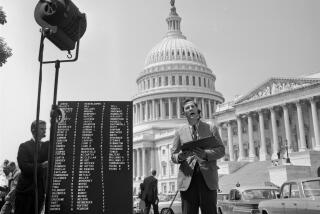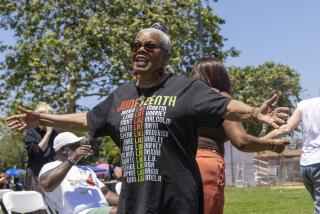The Independence Day That Wasn’t
- Share via
Today marks the 50th anniversary of Philippine independence from the United States. You might think that Filipinos would be dancing in the streets. After all, when the Stars and Stripes was lowered at Manila’s Luneta Park on this date in 1946 and the Philippine flag raised in its place, a rain-soaked crowd of 400,000 cheered wildly and church bells clanged throughout the archipelago.
Speaking to the assembled throng, Sen. Millard Tydings of Maryland called the day “one of the most unprecedented, most idealistic and most far-reaching events in all recorded history.” Hyperbole notwithstanding, it was a remarkable spectacle: the world’s preeminent power voluntarily relinquishing sovereignty over a nation it had acquired 48 years earlier in the Spanish-American War. When one considers the two decades of anti-colonial struggles that exploded throughout Asia, Africa and the Middle East after World War II, the U.S. move seems no less extraordinary today.
While Philippine President Fidel V. Ramos included a July 4 ceremony among an ongoing series of events this year marking the centennial of the Philippine revolution against Spain, most Filipinos remain oblivious to the anniversary; many view it with bittersweet emotions.
Although Filipinos generally hold the United States in high regard, many think of July 4 as the independence day that wasn’t. Philippine historians rightly point out that the U.S. gift of independence in 1946 came with strings attached. The U.S. retained sovereignty over dozens of military bases, and Congress passed legislation designed to ensure that the Philippines would remain a virtual U.S. economic ward.
The Bell Trade Act prohibited the Philippines from manufacturing or selling any products that might “come into substantial competition” with U.S.-made goods and required that the Philippine constitution grant U.S citizens and corporations equal access to Philippine minerals, forests and other natural resources. As Americans relax around their barbecues this Independence Day, we might consider how our own forefathers would have reacted had such a provision been demanded by Britain as part of the Treaty of Paris ending the Revolutionary War.
The terms of the Bell Act were so onerous that even the State Department opposed it. One official described the law as “clearly inconsistent with the basic foreign economic policy of this country” and a betrayal of “our promise to grant the Philippines genuine independence.”
But the incipient island republic had little choice but to accept the extortionist terms of its sovereignty. The war had left Manila in ruins and much of the countryside ravaged. Government coffers were empty, people were starving and Washington was threatening to withhold rehabilitation relief unless the Bell Act was ratified. The Philippine Congress grudgingly obliged on July 2, 1946.
Filipino nationalists were never happy about the July 4 holiday with its bands and parades, and in 1962 they prevailed upon President Diosdado Macapagal to change the date. Macapagal chose June 12, which commemorates a declaration of independence: by Filipino revolutionaries who in 1898 proclaimed their freedom from Spain.
Historians generally agree that the Philippine revolution, the first Asian uprising against a foreign imperial power, would eventually have triumphed over Spain had it not been for the short-lived Spanish-American War, which saw the Americans elbow aside the Filipino revolutionaries. Once victorious, the Americans purchased the islands for $20 million and set about colonizing them.
In 1898, President William McKinley declared the U.S. mission in the Philippines one of “benevolent assimilation.” But within weeks of McKinley’s remarks, American troops embarked on a bloody campaign to stamp out an indigenous independence movement that would ultimately cost somewhere between 200,000 and 500,000 Filipino lives. Mark Twain called the Philippine-American War (which the U.S. called the “Philippine Insurrection”) “a mess, a quagmire from which each fresh step renders the difficulty of extrication immensely greater.”
On July 4, 1901, the U.S. established a civilian government in Manila and made advocacy of independence a crime punishable by a year in prison. The next year, also on July 4, President Theodore Roosevelt declared the Philippine-American War ended, even though freedom fighters, referred to as “bandits” and “outlaws” by the Americans, continued fighting in the countryside for several more years.
If you ask Filipinos today when their country finally achieved independence, many say they can’t answer the question. Educated Filipinos talk about a process that began with the 1896 uprising against Spain by Andres Bonifacio or the 1898 declaration. Some pay lip service to the July 4, 1946, date, noting its limitations. Others say that independence finally came with the downfall of the Ferdinand Marcos dictatorship in 1986.
The most frequent answer I received in a series of recent conversations with Filipino academics was Sept. 16, 1991--the date that the Philippine Senate boldly refused to extend the U.S. lease at the Subic Bay Naval Station. Alex Magno, a University of the Philippines political scientist, said that psychologically, Filipinos were not free of the U.S. until then. “Until 1991, the ghost of the Philippine-American War still haunted us,” Magno said.
Today, the Philippines is in the midst of an economic and political revival. Subic Bay is one of a half-dozen boom towns that have attracted billions of dollars of overseas investments. Last year, the economy grew by an impressive 5.7%. The country has demonstrated that it can ensure a peaceful, democratic transition from one administration to the next, something that was much in doubt only a few years ago.
And Filipinos, 73 million of them in a nation of 7,100 islands, probably have a better sense of their national identity than at any time since the revolution of 1898 itself. They also have a more acute appreciation of the legacy of U.S. colonialism, not only of the impediments that were placed in the way of development but of America’s rich democratic traditions as well.
More to Read
Sign up for Essential California
The most important California stories and recommendations in your inbox every morning.
You may occasionally receive promotional content from the Los Angeles Times.













